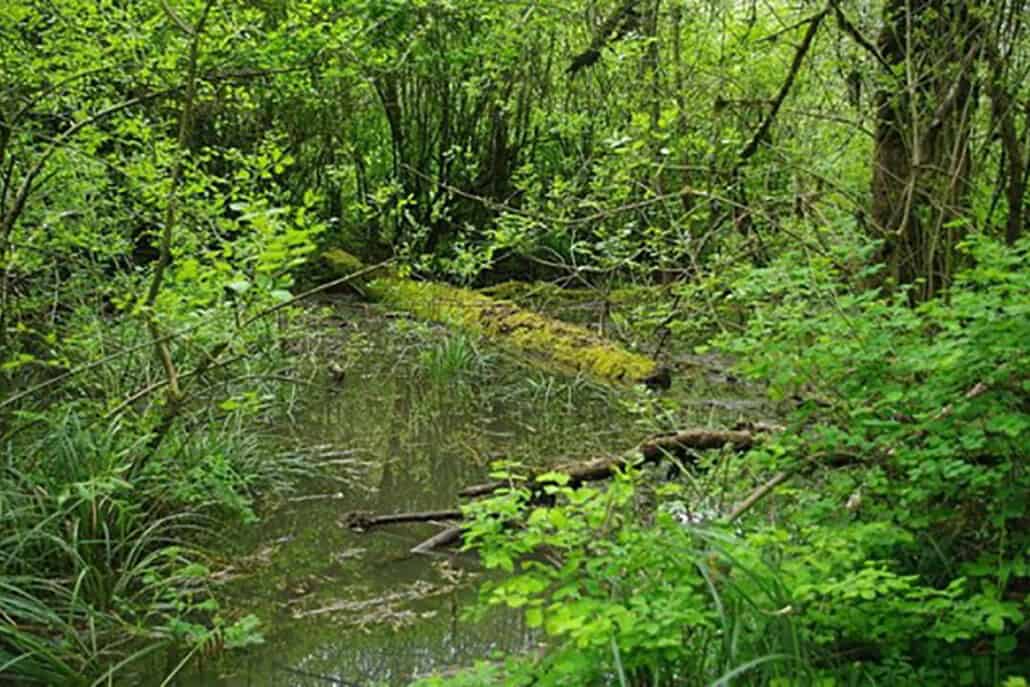1. Tundra Swan

Measuring more than 50 inches in length with a wingspan of up to seven feet, the tundra swan is one of the largest birds in North America. It breeds, as its name implies, in the farthest reaches of Canada and Alaska, but North Carolinians can see it easily during winter, when vast numbers come to the coastal plain to escape the frigid north. The greatest concentrations are at Lake Mattamuskeet, where thousands may be viewed from several vantage points. Smaller flocks or individuals occur at various other points up and down the shore.
Adult tundra swans, with their crisp white plumage, long necks, and black bills, are the epitome of beauty and grace. Gray immatures share the same elegant form but not the pristine plumage of their parents. Nevertheless they are a breathtaking sight when together they swim across the mirrored surface of a quiet lake in numbers almost beyond counting.
Tundra swans mate for life and family groups remain together through their first winter. Generation after generation, identical birds will wing their way over the continent, seeking out the same North Carolina wintering grounds and delighting their southern hosts.
This species was originally called the whistling swan, named by the explorers Lewis and Clark for the notes it utters in flight.
2. Peregrine Falcon
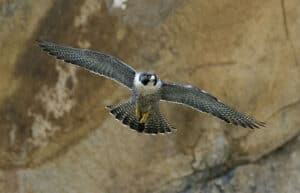
The swift and powerful peregrine falcon is an environmental success story still being written. It was almost a disaster: Less than 40 years ago the species was in danger of extinction in most of its historic U.S. range because of the eggshell-thinning effects of the pesticide DDT. But a massive captive-breeding and reintroduction effort was undertaken just in time, and little by little, mated peregrines began to return to former breeding areas.
North Carolina is now home to a half-dozen or more of these “new” peregrine pairs that return year after year to claim their spots on secluded mountain cliffs at the western end of the state. One of these sites, in Pisgah National Forest, is visible with binoculars or telescope from the Devils Courthouse overlook at Milepost 422.4 on the Blue Ridge Parkway. Activity is most obvious there during April and May, when nestlings are being fed or newly fledged young are starting to try their wings in flight.
The peregrine is a fairly large (crow-sized) bird with long pointed wings designed for speed. Adults are blue-black above with dark barring below; immatures are similar but browner. All ages show the distinctive dark sideburns and a clear, light throat. Said to be one of the fastest birds in the world, the peregrine falcon has been clocked at more than 180 mph as it dives for prey.
Migrant peregrines may also be seen from hawk watch locations during the fall, and overwintering birds occur in the state as well. But the best and most consistent peregrine observations come from the nesting areas. National Forest rangers can usually give up-to-date information on the status of different pairs every spring.
3. Northern Saw-whet Owl
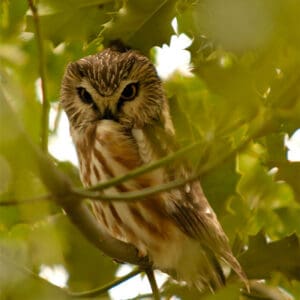
Only six inches high and looking more like a toy than the fierce predator it is, the northern saw-whet owl is the rarest of the breeding owls of North Carolina. Its range is limited to the transition zone between spruce-fir and northern hardwood forests at high elevations in the western mountains. It is generally unobtrusive except during breeding season, April into June, when — if weather conditions are favorable — males may be heard calling at dusk or during the night in appropriate habitat.
Experts believe this species will seldom use the same nest site two years in a row, meaning that birders seeking to hear or see a saw-whet must search for it anew each year. The Blue Ridge Parkway is an easy entree into saw-whet territory, however, and by driving slowly along as night falls in high-elevation areas you may be able to locate a calling male.
On rare occasions at any time of year a lucky mountain hiker will discover a roosting saw-whet owl, sitting quietly at the edge of a trail in the sheltering branches of a pine. Such birds are often tame and approachable, allowing close observation. What these fortunate viewers see is a compact little creature of typical owl shape with large tuftless head, no obvious neck, and huge yellow eyes. Adults are streaked with brown while juveniles are more colorful, displaying a tawny ochre breast, chocolate upperparts and a bold white patch between the eyes.
4. Golden-crowned Kinglet

This little sprite, one of the smallest birds in North America, is found somewhere in North Carolina in every month of the year. It is primarily a “northern” species, though, so most Tarheel residents get to see it only during winter when large numbers come south to escape the most frigid weather. But in the mountain counties the golden-crowned kinglet is present year-round, because much of the winter population merely travels uphill in spring to breed in the high-elevation conifer forests along the mountain chain.
To find golden-crowned kinglets in winter it helps to recognize their distinctive high-pitched tsee-see-see calls, which are uttered frequently and often draw attention to birds. When you hear it, look up and search for tiny (3 1/2-inch) birds, olive-backed with orange or yellow crowns bordered by a black line and a white “eyebrow.” Sometimes they are identifiable by their behavior as they flit erratically through the trees, flicking their wings in mid-air or clinging, upside-down, from the tips of branches hunting for insect prey. Golden-crowned kinglets usually travel in flocks, often six or eight birds together, and sometimes hook up with other small woodland birds such as chickadees, titmice, downy woodpeckers, and nuthatches as they scour a winter woodland for food.
On their breeding grounds in the mountains golden-crowned kinglets may be heard whistling their high-pitched songs at the tops of the tallest trees.
5. Brown-headed Nuthatch
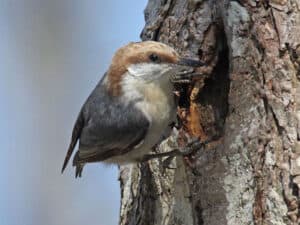
Throughout pine woodlands in the piedmont and coastal plain, the little (4 1/2-inch) brown-headed nuthatch is a common resident and a favorite of local birders and visitors. Similar in basic form to North Carolina’s other familiar nuthatches, the white-breasted of deciduous forests and the red-breasted of high-elevation coniferous sites, the brown-headed nuthatch is distinguished by its gray back, white belly and cheek, and brown cap. A small pale spot on the nape is always present but not easy to see. Brown-headed nuthatches usually travel in small groups and communicate constantly with excited twitters and chips.
Birders who know only the white-breasted nuthatch may be surprised to see that the brown-headed is fully an inch smaller — an obvious difference at that size.
Brown-headed nuthatches will visit seed feeders in piney neighborhoods, and when feeding on natural foods they forage in the manner of other nuthatches—creeping down and around tree trunks and branches, searching crevices for hidden edibles. They nest in natural cavities, old woodpecker holes, or in backyard birdhouses in suitable habitat.
Brown-headed nuthatches are nonmigratory and most individuals stay within the same restricted areas through their entire lives.
6. Red-cockaded woodpecker
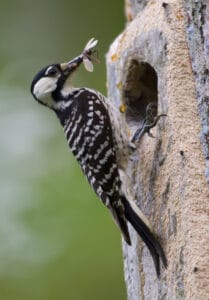
The red-cockaded woodpecker is an example of how overspecialization can harm a species and cause it to become endangered. Red-cockadeds require a mature pine forest habitat with an open understory of the type created by frequent wildfires. They build their cavity nests in 80 to 100-year-old trees that are infected with red heart fungus, a disease that softens the inner wood and makes it more suitable for excavation. Because commercial tree harvesting does not generally allow woodlands to reach these conditions, red-cockaded habitat has been disappearing for years and is now found primarily on public lands managed specifically for these birds. Weymouth Woods Nature Preserve in the Sandhills region is one such place. Nearer the coast, red-cockadeds may also be found in both north and south sections of the Croatan National Forest or in the Green Swamp area.
The easiest time to find red-cockaded woodpeckers is during nesting season in late April and May. Their nest trees, covered with sap from holes bored by the birds to repel predators, are whitish-looking from a distance and quite visible. Birds can be viewed as they go in and out of the nest hole. Notice how the parent birds are aided by “helpers,” unmated young, usually males, from their previous nesting cycle.
Red-cockaded woodpeckers are black and white ladder-backed birds with a round white cheek patch and solid black tail. Their “cockade” is a tiny red dot on the side of the face, quite hard to see.
7. Blackburnian Warbler

Described as “fiery” or “glowing like an ember” the Blackburnian warbler is one of the most visually exciting of all warblers and finding one is a highlight of any birder’s day. The male Blackburnian has a bright orange throat and orange head streaks set off by black back and wings with white accents. Females are similar, but buttery-yellow where the males are orange. Blackburnian warblers are long-distance migrants, arriving in North Carolina in April after a flight from South America where they winter in the Andes.
As migrants here on their way to nesting grounds farther north, Blackburnians may be seen widely, though unpredictably. But Tarheel birders don’t have to rely on serendipitous encounters, because there are breeding populations of Blackburnians scattered in our own western mountains. From the spruce-fir forests of the highest slopes through mixed woodlands to about 3,000-foot elevation, Blackburnian warblers nest high in the tops of the tallest trees. They are most active and easiest to see in April and May.
Blackburnians may be found at many stopping points along the Blue Ridge Parkway as well as along foot trails in adjacent national forests. One of the most accessible sites to find them is the Pink Beds Recreation Area, which is located next to the Cradle of Forestry Interpretive Center on U.S. Route 276 just south of the Parkway in Transylvania County. Listen for the males’ high, lispy songs in trees around the parking lot and along the Pink Beds trail as it circles through the woods.
8. Prothonotary Warbler
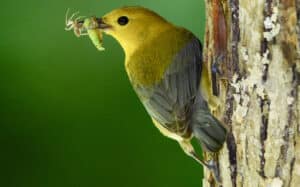
A denizen of wooded southern swamps, the yellow-hooded prothonotary warbler was named after Roman Catholic papal scribes, who wore hooded garments of the same color. It is the only eastern warbler which nests in tree cavities and has even been known to occupy birdhouses erected at the edge of a suitable swamp.
The male prothonotary glitters like gold as it flies about in its wet shady habitat. Its entire head and belly are sun-yellow, offset only by a beady black eye. The back and wings are solid gray. Females are similar to males, but their yellow color is more subdued. The song is a monotonous series of chirpy notes all on one pitch.
Prothonotary warblers are quite common in proper wet situations throughout the South. In North Carolina they breed not only in cypress swamps but also in other kinds of wooded swamps, and in heavily wooded edges of streams, rivers and lakes, where nest holes are plentiful and standing or slow-moving water covers the ground. Some prothonotaries are also found in moist woods with a damp (not wet) floor.
Prothonotary warblers are common at Great Dismal Swamp National Wildlife Refuge, Merchants Millpond State Park, Lake Mattamuskeet, and many other coastal plain locations. Summer residents, they are present from April into August or September.
9. Painted Bunting

A six-year-old child with a box of crayons and a bold imagination might create a bird that looks something like the male painted bunting. No one else could possibly imagine it. Start with a royal blue head and shoulders. Add a cherry red belly, throat, rump and eye-ring. Color in a lime-green upper back, and then finish off with olive-brown wings and tail. Presto! A painted bunting! If a new birder came upon this bird unprepared, he might well exclaim, “Am I dreaming? Is this for real?”
It’s for real, all right. Along with its greenish mate, the painted bunting is a summer resident in several parts of the South, including the south Atlantic coast. In North Carolina it is principally found in the barrier islands and immediate coastal areas, from Carteret County south, though distribution is spotty and many seemingly suitable sites are unclaimed.
Painted buntings prefer dense shrubby thickets and similar overgrown areas and are present from April into early fall. Occasionally one will remain for the winter, sustained by someone’s backyard feeder, but that is rare.
Good places to search for painted buntings in North Carolina are Hammocks Beach State Park, Carolina Beach State Park, and Fort Macon State Park.
10. Red Crossbill
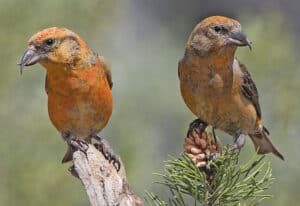
This unusual finch has intrigued birders for generations. Its winter wanderings in search of food are erratic and unpredictable. It has been known to breed in almost every month of the year. It is so variable in size, voice, and feeding preferences that ornithologists believe that what we call “red crossbill” may actually be as many as eight different species. And though these birds nest widely in the northern and western United States and Canada, there is one other, isolated breeding population — in the mountains of North Carolina. Southern birders, especially, journey to the Tarheel state to see this bird at any time of year.
Not that finding red crossbills here is easy; it isn’t. Flocks meander all over the mountains and unless they are nesting, do not often remain in one place for long. Mount Mitchell State Park is a fairly reliable place to look for this species, however. It pays to listen to tapes of the crossbills’ kip-kip-kip flight calls ahead of time, because recognizing them will alert you to the presence of a flock.
Five to six inches long, male red crossbills are raspberry red over most of the body; females are yellowish-olive, with a yellow rump patch. Both have dark wings and tail and both exhibit the unique crossed-at-the-tip bill that helps them to open pinecones to extract the seeds inside.


